
Apple Shifts Gears on AR Strategy Amid Meta’s Groundbreaking Orion Release
2024-09-30
Apple Reevaluates AR Strategy
In a surprising turn of events, Apple appears to be reevaluating its approach to augmented reality (AR) following the unveiling of Meta’s innovative AR glasses prototype, Orion, as reported by Bloomberg's Mark Gurman. While Apple has long championed its own spatial computing solutions, recent developments may push the tech giant to rethink its current trajectory.
Meta’s Orion: A Game Changer
The launch of Meta’s Orion has reportedly set off alarms in Cupertino, especially around its unique features that differentiate it from Apple's Vision Pro. Unlike Apple’s approach that integrates virtual reality (VR) into an immersive environment through displays and tracking technology, Orion utilizes transparent holographic displays, allowing users to perceive the real world clearly while enhancing it with virtual capabilities.
Innovative Control Mechanism
Orion's standout feature lies in its advanced control mechanism through electromyography (EMG), which detects subtle muscle movements for gesture recognition. This results in a more precise and interactive user experience compared to traditional hand-tracking methods employed by other devices. Furthermore, Meta’s decision to design a 'Wireless Compute Puck,' transferring processing power away from the headset, showcases a clever approach in utilizing external hardware, thus eliminating cumbersome wires and heavy battery packs—something that has been a limitation for Apple's Vision Pro.
Apple's Strategic Considerations
In response to these developments, Apple is contemplating several strategic pathways. One option could be to persist with its current Vision Pro model while aiming for a more affordable version. However, with the Quest 3S priced at a mere $300—drastically lower than Vision Pro’s $3,500 tag—rolling out a cost-effective alternative might present significant challenges in capturing the consumer market. Should Apple decide to pursue this route, a follow-up model, potentially dubbed Vision Pro 2, may be in the works.
Possibility of iPhone Integration
Alternatively, Apple has the opportunity to innovate by using the iPhone as a processing unit for a new Vision headset. Such a move would not only reduce the headset's weight and cost but would also cement the iPhone as an essential companion device, distinguishing it from Meta’s standalone options.
Potential for Smarter Glasses
There is also speculation that Apple might draw inspiration from Meta’s Ray-Ban smart glasses—products that incorporate cameras for photography and AI functionalities but lack true AR capabilities. This could lead to the creation of smarter glasses akin to an AI-driven version of AirPods, potentially laying the groundwork for more advanced integration with future iterations of the AirPods Pro.
The Challenge of Standalone AR Glasses
The most ambitious yet daunting path would be to develop fully integrated standalone AR glasses, encapsulating battery, processing power, and tracking technologies within the device. This vision aligns with CEO Tim Cook’s ambitions, although it poses substantial developmental hurdles.
Meta’s Current Advantage
As Apple navigates these choices, experts like Gurman indicate that Meta may currently hold the upper hand in terms of AR innovation and technology, even with features still under wraps. Initially intended as a consumer product, Meta’s Orion may not see immediate market release; however, its prototype phase will allow developers to explore new AR applications, ensuring Meta stays ahead in the competitive AR landscape.
Future Implications for Apple and Meta
As we await Apple's next move in this rapidly evolving arena, tech enthusiasts and industry pundits are left to wonder: Will Apple rise to the occasion, or will it fall behind as Meta continues to redefine the AR landscape?




 Brasil (PT)
Brasil (PT)
 Canada (EN)
Canada (EN)
 Chile (ES)
Chile (ES)
 España (ES)
España (ES)
 France (FR)
France (FR)
 Hong Kong (EN)
Hong Kong (EN)
 Italia (IT)
Italia (IT)
 日本 (JA)
日本 (JA)
 Magyarország (HU)
Magyarország (HU)
 Norge (NO)
Norge (NO)
 Polska (PL)
Polska (PL)
 Schweiz (DE)
Schweiz (DE)
 Singapore (EN)
Singapore (EN)
 Sverige (SV)
Sverige (SV)
 Suomi (FI)
Suomi (FI)
 Türkiye (TR)
Türkiye (TR)